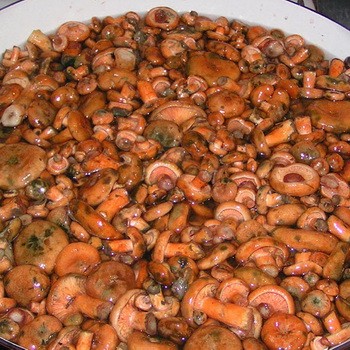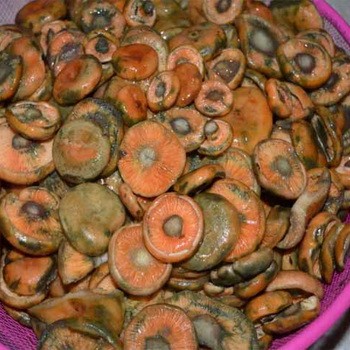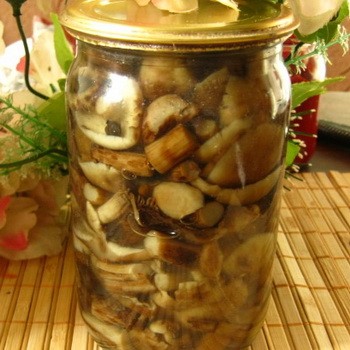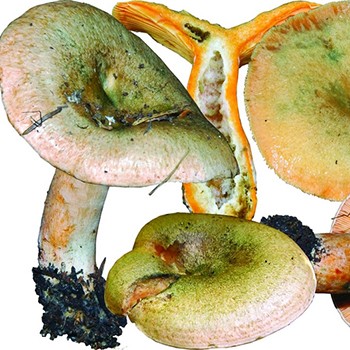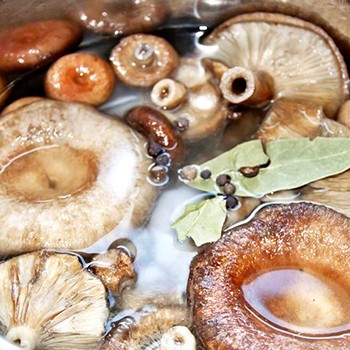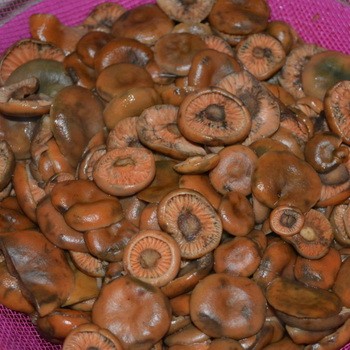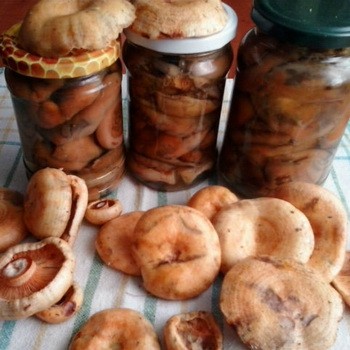What to do if mushrooms turn blue during cooking?
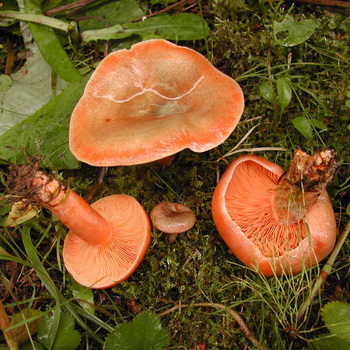
For lovers of "silent hunting" to stock up with saffron milk caps - a big success. However, the question often arises of how to keep the product for a long time? Salting will help to cope with this, which allows you to quickly “preserve” useful substances, as well as get a ready-made snack in the shortest possible time. I must say that saffron mushrooms are considered to be the only fruiting bodies that can be eaten as early as one and a half to two weeks after the start of pickling. A wonderful appetizer of these mushrooms will complement the range of dishes on the festive and everyday table.
Many housewives involved in pickling mushrooms noticed that there are situations when mushrooms turn blue in the cooking process. Is it possible to correct the situation and return the original color of saffron milk?
Content
- Is it possible to eat mushrooms that have turned blue during cooking?
- Can mushrooms be salted if the mushrooms turn blue in raw form?
- Why did the spruce and boron mushrooms turn blue when salted?
- Other reasons why the mushrooms turn blue after salting
- Why did the salted saffron mushrooms turn blue and what to do in this case?
Is it possible to eat mushrooms that have turned blue during cooking?
If the camelina is blue during the preparation of the snack, you should not worry. Perhaps some spices that were used in salting, interacting with mushrooms, led to similar changes. It is worth noting that home canning of mushrooms has unified algorithms, but does not imply a specific set of rules that should be followed. The list of those spices and spices that are laid in a bowl with mushrooms will depend on your taste preferences. Even with accuracy to say how many days the fruiting bodies will be salted, no one can. Is it possible then to have saffron milk mushrooms that have turned blue for one reason or another?
It's okay that the mushrooms have changed color, no. As mentioned above, spices and spices, such as dill or its seeds, could affect this. Therefore, if mushrooms mushrooms turn blue, they can be eaten. But to correct the situation and bring the color to its original state, you will not succeed.
Can mushrooms be salted if the mushrooms turn blue in raw form?
It often happens that even in raw form mushrooms mushrooms turn blue, is it possible to salt them in this case? Interestingly, spruce mushrooms have a flesh that produces sweet juice when cut, which, when exposed to air, acquires a bluish tint. Boron species of saffron mushrooms also secrete juice when cut, but when exposed to air, their body acquires a greenish tint. This does not affect the quality of future workpieces at all. Therefore, the color-changing mushrooms are also suitable for salting, like other species. If the spruce ryzhik turns blue during salting, this is a frequent occurrence, and it does not affect the taste and aroma of mushrooms. But if fruiting bodies turned black during salting, then the question is about their corruption. In the case when the workpiece has an unpleasant odor and mold of black color, then it should never be eaten in order not to poison.
What should I do if the collected mushrooms turn blue and they should be salted? First of all, the mushrooms are carefully sorted, cleaned of forest debris, washed in a large amount of water and proceed to salting. To do this, take salt at the rate of 40-50 g per 1 kg of the main product. As for spices, here the question is purely individual: someone prefers to use only a preservative when salting saffron mushrooms, and someone prefers fragrant and black pepper (peas), cloves, bay leaf, dill and others. So that the mushrooms do not turn blue when salting, they must be salted in enameled containers, wooden barrels or glass jars. Other dishes may cause discoloration in fruiting bodies.
Why did the spruce and boron mushrooms turn blue when salted?
Spruce and pine forest mushrooms can turn blue during the salting process due to the fact that they add too many spices. This is what can provoke a significant color change. Other types of fruiting bodies can be salted with a lot of spices, but not mushrooms. It is best to always salt these mushrooms with a minimum amount of spices, using one preservative - salt.
If salty mushrooms turn blue, is it possible to eat them or is it better not to do this? As already mentioned, the blueness of the fruit bodies does not mean corruption, which means that you can use them without any fear.
Other reasons why the mushrooms turn blue after salting
Another reason why salty mushrooms turn blue may be their improper storage. Store dishes with salty fruit bodies in a well-ventilated and cool room. The most suitable temperature for storing mushroom preservation is + 8 + 10 ° С. If the temperature is below this norm, the mushrooms can freeze. Because of this, they will crumble and lose their taste. At elevated temperatures, the mushrooms become acidic, blacken and deteriorate. In addition, each housewife must ensure that the mushrooms are completely in the brine. If there is not enough liquid, fruit bodies are added with cold boiled water. All these methods help to prevent blueing of camelina.
Also, the reason why the mushrooms turned blue after salting may be a long storage of an open can of mushrooms, even if it was in the refrigerator. Already the first discovery of canned saffron mushrooms can disrupt their environment, and the oxidation process begins to take place much more intensively. Do not leave mushrooms in jars for a long time, especially if they are not completely covered with brine.
Why did the salted saffron mushrooms turn blue and what to do in this case?
So that fresh saffron mushrooms do not turn blue, usually experienced housewives immediately scalp them with boiling water immediately after the initial treatment or lower them into boiling water with the addition of citric acid for 2-3 minutes. But it happens that salted saffron mushrooms turn blue, why is this happening? Perhaps for some time conservation with mushrooms was in the light and interacted with air. This happens with poor-quality cans or poor handling before pickling. In this case, the mushrooms are washed and poured with new saline.
What to do if mushrooms turn blue in brine? You should not throw away fruiting bodies, they are completely edible and remain an excellent snack for any festive feast. Usually, the face of camelina is a natural reaction to oxidation.
When collecting saffron milk mushrooms should always be handled with care so as not to wrinkle. This is a very effective advice to keep these fruit bodies attractive.
In addition, so that the mushrooms do not turn blue, it is better to preserve them in glass jars, with a capacity of 0.5 l: you open one jar and immediately eat it. Mushrooms just do not have time to change their color.
If you do not want the mushrooms to change color, use the equally popular processing method - pickling. But in this case, during the preliminary boiling, add a couple of a pinch of citric acid. Then the mushrooms retain their natural red color.
